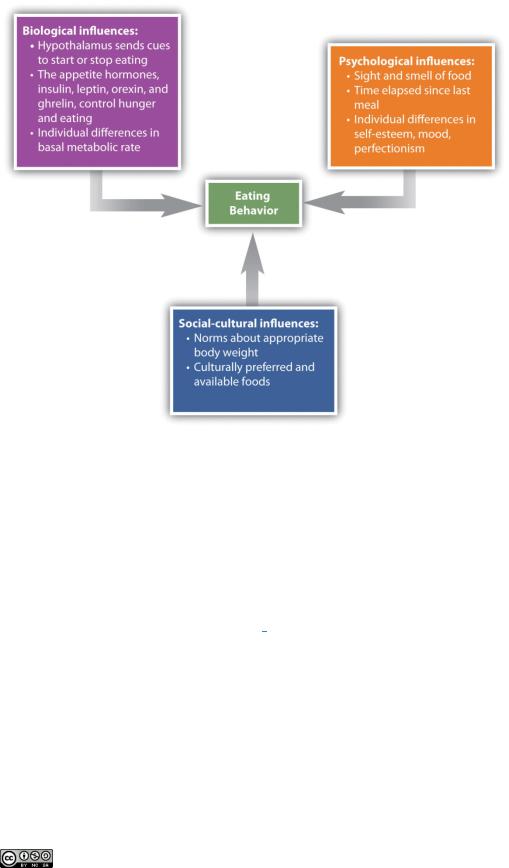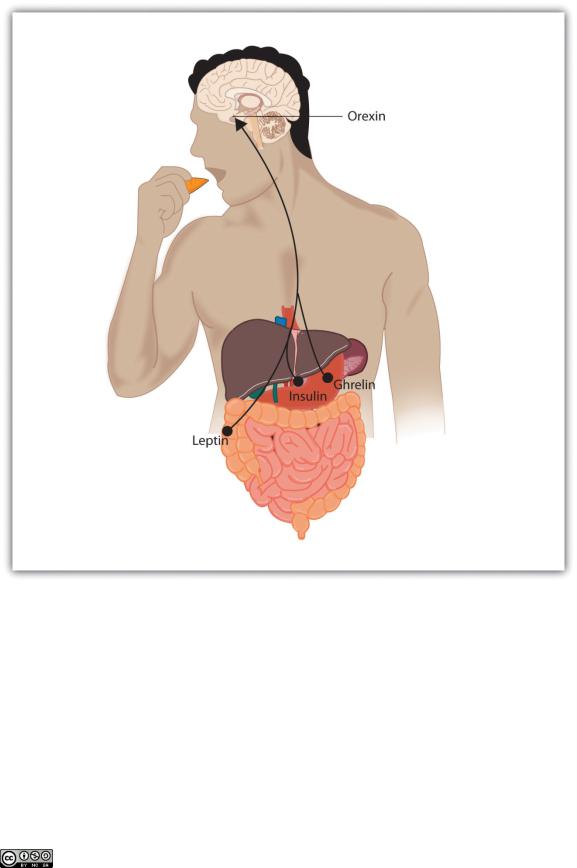
- •Preface
- •Approach and Pedagogy
- •Chapter 1
- •Introducing Psychology
- •1.1 Psychology as a Science
- •The Problem of Intuition
- •Research Focus: Unconscious Preferences for the Letters of Our Own Name
- •Why Psychologists Rely on Empirical Methods
- •Levels of Explanation in Psychology
- •The Challenges of Studying Psychology
- •1.2 The Evolution of Psychology: History, Approaches, and Questions
- •Early Psychologists
- •Structuralism: Introspection and the Awareness of Subjective Experience
- •Functionalism and Evolutionary Psychology
- •Psychodynamic Psychology
- •Behaviorism and the Question of Free Will
- •Research Focus: Do We Have Free Will?
- •The Cognitive Approach and Cognitive Neuroscience
- •The War of the Ghosts
- •Social-Cultural Psychology
- •The Many Disciplines of Psychology
- •Psychology in Everyday Life: How to Effectively Learn and Remember
- •1.3 Chapter Summary
- •Chapter 2
- •Psychological Science
- •Psychological Journals
- •2.1 Psychologists Use the Scientific Method to Guide Their Research
- •The Scientific Method
- •Laws and Theories as Organizing Principles
- •The Research Hypothesis
- •Conducting Ethical Research
- •Characteristics of an Ethical Research Project Using Human Participants
- •Ensuring That Research Is Ethical
- •Research With Animals
- •APA Guidelines on Humane Care and Use of Animals in Research
- •Descriptive Research: Assessing the Current State of Affairs
- •Correlational Research: Seeking Relationships Among Variables
- •Experimental Research: Understanding the Causes of Behavior
- •Research Focus: Video Games and Aggression
- •2.3 You Can Be an Informed Consumer of Psychological Research
- •Threats to the Validity of Research
- •Psychology in Everyday Life: Critically Evaluating the Validity of Websites
- •2.4 Chapter Summary
- •Chapter 3
- •Brains, Bodies, and Behavior
- •Did a Neurological Disorder Cause a Musician to Compose Boléro and an Artist to Paint It 66 Years Later?
- •3.1 The Neuron Is the Building Block of the Nervous System
- •Neurons Communicate Using Electricity and Chemicals
- •Video Clip: The Electrochemical Action of the Neuron
- •Neurotransmitters: The Body’s Chemical Messengers
- •3.2 Our Brains Control Our Thoughts, Feelings, and Behavior
- •The Old Brain: Wired for Survival
- •The Cerebral Cortex Creates Consciousness and Thinking
- •Functions of the Cortex
- •The Brain Is Flexible: Neuroplasticity
- •Research Focus: Identifying the Unique Functions of the Left and Right Hemispheres Using Split-Brain Patients
- •Psychology in Everyday Life: Why Are Some People Left-Handed?
- •3.3 Psychologists Study the Brain Using Many Different Methods
- •Lesions Provide a Picture of What Is Missing
- •Recording Electrical Activity in the Brain
- •Peeking Inside the Brain: Neuroimaging
- •Research Focus: Cyberostracism
- •3.4 Putting It All Together: The Nervous System and the Endocrine System
- •Electrical Control of Behavior: The Nervous System
- •The Body’s Chemicals Help Control Behavior: The Endocrine System
- •3.5 Chapter Summary
- •Chapter 4
- •Sensing and Perceiving
- •Misperception by Those Trained to Accurately Perceive a Threat
- •4.1 We Experience Our World Through Sensation
- •Sensory Thresholds: What Can We Experience?
- •Link
- •Measuring Sensation
- •Research Focus: Influence without Awareness
- •4.2 Seeing
- •The Sensing Eye and the Perceiving Visual Cortex
- •Perceiving Color
- •Perceiving Form
- •Perceiving Depth
- •Perceiving Motion
- •Beta Effect and Phi Phenomenon
- •4.3 Hearing
- •Hearing Loss
- •4.4 Tasting, Smelling, and Touching
- •Tasting
- •Smelling
- •Touching
- •Experiencing Pain
- •4.5 Accuracy and Inaccuracy in Perception
- •How the Perceptual System Interprets the Environment
- •Video Clip: The McGurk Effect
- •Video Clip: Selective Attention
- •Illusions
- •The Important Role of Expectations in Perception
- •Psychology in Everyday Life: How Understanding Sensation and Perception Can Save Lives
- •4.6 Chapter Summary
- •Chapter 5
- •States of Consciousness
- •An Unconscious Killing
- •5.1 Sleeping and Dreaming Revitalize Us for Action
- •Research Focus: Circadian Rhythms Influence the Use of Stereotypes in Social Judgments
- •Sleep Stages: Moving Through the Night
- •Sleep Disorders: Problems in Sleeping
- •The Heavy Costs of Not Sleeping
- •Dreams and Dreaming
- •5.2 Altering Consciousness With Psychoactive Drugs
- •Speeding Up the Brain With Stimulants: Caffeine, Nicotine, Cocaine, and Amphetamines
- •Slowing Down the Brain With Depressants: Alcohol, Barbiturates and Benzodiazepines, and Toxic Inhalants
- •Opioids: Opium, Morphine, Heroin, and Codeine
- •Hallucinogens: Cannabis, Mescaline, and LSD
- •Why We Use Psychoactive Drugs
- •Research Focus: Risk Tolerance Predicts Cigarette Use
- •5.3 Altering Consciousness Without Drugs
- •Changing Behavior Through Suggestion: The Power of Hypnosis
- •Reducing Sensation to Alter Consciousness: Sensory Deprivation
- •Meditation
- •Video Clip: Try Meditation
- •Psychology in Everyday Life: The Need to Escape Everyday Consciousness
- •5.4 Chapter Summary
- •Chapter 6
- •Growing and Developing
- •The Repository for Germinal Choice
- •6.1 Conception and Prenatal Development
- •The Zygote
- •The Embryo
- •The Fetus
- •How the Environment Can Affect the Vulnerable Fetus
- •6.2 Infancy and Childhood: Exploring and Learning
- •The Newborn Arrives With Many Behaviors Intact
- •Research Focus: Using the Habituation Technique to Study What Infants Know
- •Cognitive Development During Childhood
- •Video Clip: Object Permanence
- •Social Development During Childhood
- •Knowing the Self: The Development of the Self-Concept
- •Video Clip: The Harlows’ Monkeys
- •Video Clip: The Strange Situation
- •Research Focus: Using a Longitudinal Research Design to Assess the Stability of Attachment
- •6.3 Adolescence: Developing Independence and Identity
- •Physical Changes in Adolescence
- •Cognitive Development in Adolescence
- •Social Development in Adolescence
- •Developing Moral Reasoning: Kohlberg’s Theory
- •Video Clip: People Being Interviewed About Kohlberg’s Stages
- •6.4 Early and Middle Adulthood: Building Effective Lives
- •Psychology in Everyday Life: What Makes a Good Parent?
- •Physical and Cognitive Changes in Early and Middle Adulthood
- •Menopause
- •Social Changes in Early and Middle Adulthood
- •6.5 Late Adulthood: Aging, Retiring, and Bereavement
- •Cognitive Changes During Aging
- •Dementia and Alzheimer’s Disease
- •Social Changes During Aging: Retiring Effectively
- •Death, Dying, and Bereavement
- •6.6 Chapter Summary
- •Chapter 7
- •Learning
- •My Story of Posttraumatic Stress Disorder
- •7.1 Learning by Association: Classical Conditioning
- •Pavlov Demonstrates Conditioning in Dogs
- •The Persistence and Extinction of Conditioning
- •The Role of Nature in Classical Conditioning
- •How Reinforcement and Punishment Influence Behavior: The Research of Thorndike and Skinner
- •Video Clip: Thorndike’s Puzzle Box
- •Creating Complex Behaviors Through Operant Conditioning
- •7.3 Learning by Insight and Observation
- •Observational Learning: Learning by Watching
- •Video Clip: Bandura Discussing Clips From His Modeling Studies
- •Research Focus: The Effects of Violent Video Games on Aggression
- •7.4 Using the Principles of Learning to Understand Everyday Behavior
- •Using Classical Conditioning in Advertising
- •Video Clip: Television Ads
- •Psychology in Everyday Life: Operant Conditioning in the Classroom
- •Reinforcement in Social Dilemmas
- •7.5 Chapter Summary
- •Chapter 8
- •Remembering and Judging
- •She Was Certain, but She Was Wrong
- •Differences between Brains and Computers
- •Video Clip: Kim Peek
- •8.1 Memories as Types and Stages
- •Explicit Memory
- •Implicit Memory
- •Research Focus: Priming Outside Awareness Influences Behavior
- •Stages of Memory: Sensory, Short-Term, and Long-Term Memory
- •Sensory Memory
- •Short-Term Memory
- •8.2 How We Remember: Cues to Improving Memory
- •Encoding and Storage: How Our Perceptions Become Memories
- •Research Focus: Elaboration and Memory
- •Using the Contributions of Hermann Ebbinghaus to Improve Your Memory
- •Retrieval
- •Retrieval Demonstration
- •States and Capital Cities
- •The Structure of LTM: Categories, Prototypes, and Schemas
- •The Biology of Memory
- •8.3 Accuracy and Inaccuracy in Memory and Cognition
- •Source Monitoring: Did It Really Happen?
- •Schematic Processing: Distortions Based on Expectations
- •Misinformation Effects: How Information That Comes Later Can Distort Memory
- •Overconfidence
- •Heuristic Processing: Availability and Representativeness
- •Salience and Cognitive Accessibility
- •Counterfactual Thinking
- •Psychology in Everyday Life: Cognitive Biases in the Real World
- •8.4 Chapter Summary
- •Chapter 9
- •Intelligence and Language
- •How We Talk (or Do Not Talk) about Intelligence
- •9.1 Defining and Measuring Intelligence
- •General (g) Versus Specific (s) Intelligences
- •Measuring Intelligence: Standardization and the Intelligence Quotient
- •The Biology of Intelligence
- •Is Intelligence Nature or Nurture?
- •Psychology in Everyday Life: Emotional Intelligence
- •9.2 The Social, Cultural, and Political Aspects of Intelligence
- •Extremes of Intelligence: Retardation and Giftedness
- •Extremely Low Intelligence
- •Extremely High Intelligence
- •Sex Differences in Intelligence
- •Racial Differences in Intelligence
- •Research Focus: Stereotype Threat
- •9.3 Communicating With Others: The Development and Use of Language
- •The Components of Language
- •Examples in Which Syntax Is Correct but the Interpretation Can Be Ambiguous
- •The Biology and Development of Language
- •Research Focus: When Can We Best Learn Language? Testing the Critical Period Hypothesis
- •Learning Language
- •How Children Learn Language: Theories of Language Acquisition
- •Bilingualism and Cognitive Development
- •Can Animals Learn Language?
- •Video Clip: Language Recognition in Bonobos
- •Language and Perception
- •9.4 Chapter Summary
- •Chapter 10
- •Emotions and Motivations
- •Captain Sullenberger Conquers His Emotions
- •10.1 The Experience of Emotion
- •Video Clip: The Basic Emotions
- •The Cannon-Bard and James-Lange Theories of Emotion
- •Research Focus: Misattributing Arousal
- •Communicating Emotion
- •10.2 Stress: The Unseen Killer
- •The Negative Effects of Stress
- •Stressors in Our Everyday Lives
- •Responses to Stress
- •Managing Stress
- •Emotion Regulation
- •Research Focus: Emotion Regulation Takes Effort
- •10.3 Positive Emotions: The Power of Happiness
- •Finding Happiness Through Our Connections With Others
- •What Makes Us Happy?
- •10.4 Two Fundamental Human Motivations: Eating and Mating
- •Eating: Healthy Choices Make Healthy Lives
- •Obesity
- •Sex: The Most Important Human Behavior
- •The Experience of Sex
- •The Many Varieties of Sexual Behavior
- •Psychology in Everyday Life: Regulating Emotions to Improve Our Health
- •10.5 Chapter Summary
- •Chapter 11
- •Personality
- •Identical Twins Reunited after 35 Years
- •11.1 Personality and Behavior: Approaches and Measurement
- •Personality as Traits
- •Example of a Trait Measure
- •Situational Influences on Personality
- •The MMPI and Projective Tests
- •Psychology in Everyday Life: Leaders and Leadership
- •11.2 The Origins of Personality
- •Psychodynamic Theories of Personality: The Role of the Unconscious
- •Id, Ego, and Superego
- •Research Focus: How the Fear of Death Causes Aggressive Behavior
- •Strengths and Limitations of Freudian and Neo-Freudian Approaches
- •Focusing on the Self: Humanism and Self-Actualization
- •Research Focus: Self-Discrepancies, Anxiety, and Depression
- •Studying Personality Using Behavioral Genetics
- •Studying Personality Using Molecular Genetics
- •Reviewing the Literature: Is Our Genetics Our Destiny?
- •11.4 Chapter Summary
- •Chapter 12
- •Defining Psychological Disorders
- •When Minor Body Imperfections Lead to Suicide
- •12.1 Psychological Disorder: What Makes a Behavior “Abnormal”?
- •Defining Disorder
- •Psychology in Everyday Life: Combating the Stigma of Abnormal Behavior
- •Diagnosing Disorder: The DSM
- •Diagnosis or Overdiagnosis? ADHD, Autistic Disorder, and Asperger’s Disorder
- •Attention-Deficit/Hyperactivity Disorder (ADHD)
- •Autistic Disorder and Asperger’s Disorder
- •12.2 Anxiety and Dissociative Disorders: Fearing the World Around Us
- •Generalized Anxiety Disorder
- •Panic Disorder
- •Phobias
- •Obsessive-Compulsive Disorders
- •Posttraumatic Stress Disorder (PTSD)
- •Dissociative Disorders: Losing the Self to Avoid Anxiety
- •Dissociative Amnesia and Fugue
- •Dissociative Identity Disorder
- •Explaining Anxiety and Dissociation Disorders
- •12.3 Mood Disorders: Emotions as Illness
- •Behaviors Associated with Depression
- •Dysthymia and Major Depressive Disorder
- •Bipolar Disorder
- •Explaining Mood Disorders
- •Research Focus: Using Molecular Genetics to Unravel the Causes of Depression
- •12.4 Schizophrenia: The Edge of Reality and Consciousness
- •Symptoms of Schizophrenia
- •Explaining Schizophrenia
- •12.5 Personality Disorders
- •Borderline Personality Disorder
- •Research Focus: Affective and Cognitive Deficits in BPD
- •Antisocial Personality Disorder (APD)
- •12.6 Somatoform, Factitious, and Sexual Disorders
- •Somatoform and Factitious Disorders
- •Sexual Disorders
- •Disorders of Sexual Function
- •Paraphilias
- •12.7 Chapter Summary
- •Chapter 13
- •Treating Psychological Disorders
- •Therapy on Four Legs
- •13.1 Reducing Disorder by Confronting It: Psychotherapy
- •DSM-IV-TR Criteria for Diagnosing Attention-Deficit/Hyperactivity Disorder (ADHD)
- •Psychology in Everyday Life: Seeking Treatment for Psychological Difficulties
- •Psychodynamic Therapy
- •Important Characteristics and Experiences in Psychoanalysis
- •Humanistic Therapies
- •Behavioral Aspects of CBT
- •Cognitive Aspects of CBT
- •Combination (Eclectic) Approaches to Therapy
- •13.2 Reducing Disorder Biologically: Drug and Brain Therapy
- •Drug Therapies
- •Using Stimulants to Treat ADHD
- •Antidepressant Medications
- •Antianxiety Medications
- •Antipsychotic Medications
- •Direct Brain Intervention Therapies
- •13.3 Reducing Disorder by Changing the Social Situation
- •Group, Couples, and Family Therapy
- •Self-Help Groups
- •Community Mental Health: Service and Prevention
- •Some Risk Factors for Psychological Disorders
- •Research Focus: The Implicit Association Test as a Behavioral Marker for Suicide
- •13.4 Evaluating Treatment and Prevention: What Works?
- •Effectiveness of Psychological Therapy
- •Research Focus: Meta-Analyzing Clinical Outcomes
- •Effectiveness of Biomedical Therapies
- •Effectiveness of Social-Community Approaches
- •13.5 Chapter Summary
- •Chapter 14
- •Psychology in Our Social Lives
- •Binge Drinking and the Death of a Homecoming Queen
- •14.1 Social Cognition: Making Sense of Ourselvesand Others
- •Perceiving Others
- •Forming Judgments on the Basis of Appearance: Stereotyping, Prejudice, and Discrimination
- •Implicit Association Test
- •Research Focus: Forming Judgments of People in Seconds
- •Close Relationships
- •Causal Attribution: Forming Judgments by Observing Behavior
- •Attitudes and Behavior
- •14.2 Interacting With Others: Helping, Hurting, and Conforming
- •Helping Others: Altruism Helps Create Harmonious Relationships
- •Why Are We Altruistic?
- •How the Presence of Others Can Reduce Helping
- •Video Clip: The Case of Kitty Genovese
- •Human Aggression: An Adaptive yet Potentially Damaging Behavior
- •The Ability to Aggress Is Part of Human Nature
- •Negative Experiences Increase Aggression
- •Viewing Violent Media Increases Aggression
- •Video Clip
- •Research Focus: The Culture of Honor
- •Conformity and Obedience: How Social Influence Creates Social Norms
- •Video Clip
- •Do We Always Conform?
- •14.3 Working With Others: The Costs and Benefits of Social Groups
- •Working in Front of Others: Social Facilitation and Social Inhibition
- •Working Together in Groups
- •Psychology in Everyday Life: Do Juries Make Good Decisions?
- •Using Groups Effectively
- •14.4 Chapter Summary

[28]Wilson, T. D., & Gilbert, D. T. (2005). Affective forecasting: Knowing what to want.Current Directions in Psychological Science, 14(3), 131–134.
[29]Brickman, P., Coates, D., & Janoff-Bulman, R. (1978). Lottery winners and accident victims: Is happiness relative? Journal of Personality and Social Psychology, 36(8), 917–927.
[30]Small, D. M., Zatorre, R. J., Dagher, A., Evans, A. C., & Jones-Gotman, M. (2001). Changes in brain activity related to eating chocolate: From pleasure to aversion. Brain, 124(9), 1720–1733.
[31]Wilson, T. D., Wheatley, T., Meyers, J. M., Gilbert, D. T., & Axsom, D. (2000). Focalism: A source of durability bias in affective forecasting. Journal of Personality and Social Psychology, 78(5), 821–836.
[32]Bonanno, G. A., Wortman, C. B., Lehman, D. R., Tweed, R. G., Haring, M., Sonnega, J.,…Nesse, R. M. (2002). Resilience to loss and chronic grief: A prospective study from preloss to 18-months postloss. Journal of Personality and Social Psychology, 83(5), 1150–1164.
[33]Lucas, R. (2007). Long-term disability is associated with lasting changes in subjective well-being: Evidence from two nationally representative longitudinal studies. Journal of Personality & Social Psychology, 92(4), 717–730. Retrieved from Academic Search Premier Database; Riis, J., Baron, J., Loewenstein, G., Jepson, C., Fagerlin, A., & Ubel, P. (2005). Ignorance of hedonic adaptation to hemodialysis: A study using ecological momentary assessment. Journal of Experimental Psychology/General, 134(1), 3–9. doi:10.1037/0096-3445.134.1.3
[34]Marinić, M., & Brkljačić,T. (2008). Loveover gold—The correlation of happiness level with some life satisfaction factors between persons with and without physical disability.Journal of Developmental & Physical Disabilities, 20(6), 527–540. doi:10.1007/s10882-008-9115-7
[35]Argyle, M. (1999). Causes and correlates of happiness. In D. Kahneman, E. Diener, & N. Schwarz (Eds.), Well being: The foundations of hedonic psychology. New York, NY: Russell Sage Foundation.
10.4 Two Fundamental Human Motivations: Eating and Mating
L E A R N I N G O B J E C T I V E S
1.Understand the biological and social responses that underlie eating behavior.
2.Understand the psychological and physiological responses that underlie sexual behavior.
Eating: Healthy Choices Make Healthy Lives
Along with the need to drink fresh water, which humans can normally attain in all except the most extreme situations, the need for food is the most fundamental and important human need.
Saylor URL: http://www.saylor.org/books |
Saylor.org |
|
516 |

More than 1 in 10 U.S. households contain people who live without enough nourishing food, and this lack of proper nourishment has profound effects on their abilities to create effective lives (Hunger Notes, n.d.). [1] When people are extremely hungry, their motivation to attain food completely changes their behavior. Hungry people become listless and apathetic to save energy and then become completely obsessed with food. Ancel Keys and his colleagues (Keys, Brožek, Henschel, Mickelsen, & Taylor, 1950) [2] found that volunteers who were placed on severely reduced-calorie diets lost all interest in sex and social activities, becoming preoccupied with food.
Like most interesting psychological phenomena, the simple behavior of eating has both biological and social determinants (Figure 10.12 "Biological, Psychological, and Social-Cultural Contributors to Eating"). Biologically, hunger is controlled by the interactions among complex pathways in the nervous system and a variety of hormonal and chemical systems in the brain and body. The stomach is of course important. We feel more hungry when our stomach is empty than when it is full. But we can also feel hunger even without input from the stomach. Two areas of the hypothalamus are known to be particularly important in eating. The lateral part of the hypothalamus responds primarily to cues to start eating, whereas the ventromedial part of the hypothalamus primarily responds to cues to stop eating. If the lateral part of the hypothalamus is damaged, the animal will not eat even if food is present, whereas if the ventromedial part of the hypothalamus is damaged, the animal will eat until it is obese (Wolf & Miller, 1964). [3]
Saylor URL: http://www.saylor.org/books |
Saylor.org |
|
517 |

Figure 10.12 Biological, Psychological, and Social-Cultural Contributors to Eating
Hunger is also determined by hormone levels (Figure 10.13 "Eating Is Influenced by the Appetite Hormones"). Glucose is the main sugar that the body uses for energy, and the brain monitors blood glucose levels to determine hunger. Glucose levels in the bloodstream are regulated by insulin, a hormone secreted by the pancreas gland. When insulin is low, glucose is not taken up by body cells, and the body begins to use fat as an energy source. Eating and appetite are also influenced by other hormones, including orexin, ghrelin, andleptin (Brennan & Mantzoros, 2006; Nakazato et al., 2001). [4]
Saylor URL: http://www.saylor.org/books |
Saylor.org |
|
518 |

Figure 10.13 Eating Is Influenced by the Appetite Hormones
Insulin, secreted by the pancreas, controls blood glucose; leptin, secreted by fat cells, monitors energy levels; orexin, secreted by the hypothalamus, triggers hunger; ghrelin, secreted by an empty stomach, increases food intake.
Normally the interaction of the various systems that determine hunger creates a balance or homeostasis in which we eat when we are hungry and stop eating when we feel full. But
homeostasis varies among people; some people simply weigh more than others, and there is little they can do to change their fundamental weight. Weight is determined in large part by
Saylor URL: http://www.saylor.org/books |
Saylor.org |
|
519 |

thebasal metabolic rate, the amount of energy expended while at rest. Each person’s basal metabolic rate is different, due to his or her unique physical makeup and physical behavior. A naturally occurring low metabolic rate, which is determined entirely by genetics, makes weight management a very difficult undertaking for many people.
How we eat is also influenced by our environment. When researchers rigged clocks to move faster, people got hungrier and ate more, as if they thought they must be hungry again because so much time had passed since they last ate (Schachter, 1968). [5] And if we forget that we have already eaten, we are likely to eat again even if we are not actually hungry (Rozin, Dow, Moscovitch, & Rajaram, 1998). [6]
Cultural norms about appropriate weights also influence eating behaviors. Current norms for women in Western societies are based on a very thin body ideal, emphasized by television and movie actresses, models, and even children’s dolls, such as the ever-popular Barbie. These norms for excessive thinness are very difficult for most women to attain: Barbie’s measurements, if translated to human proportions, would be about 36 in.-18 in.-33 in. at bust-waist-hips, measurements that are attained by less than 1 in 100,000 women (Norton, Olds, Olive, & Dank, 1996). [7] Many women idealize being thin and yet are unable to reach the standard that they prefer.
Eating Disorders
In some cases, the desire to be thin can lead to eating disorders, which are estimated to affect about 1 million males and 10 million females the United States alone (Hoek & van Hoeken, 2003; Patrick, 2002). [8] Anorexia nervosais an eating disorder characterized by extremely low body weight, distorted body image, and an obsessive fear of gaining weight. Nine out of 10 sufferers are women. Anorexia begins with a severe weight loss diet and develops into a preoccupation with food and dieting.
Bulimia nervosa is an eating disorder characterized by binge eating followed by purging. Bulimia nervosa begins after the dieter has broken a diet and gorged. Bulimia involves repeated episodes of overeating, followed by vomiting, laxative use, fasting, or excessive exercise. It is most common in women in their late teens or early 20s, and it is often accompanied by
Saylor URL: http://www.saylor.org/books |
Saylor.org |
|
520 |
